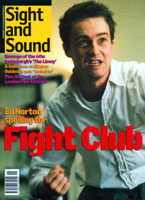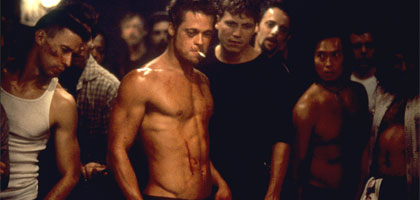Primary navigation


Fight Club is about the monstrous thrill of violence and the fragility of men - and that's not all, argues Amy Taubin
David Fincher's Fight Club opens inside the fear centre of its protagonist's brain, although we don't realise that's where we are until we're no longer there. What we see is a semi-dark space that seems both confined and limitless, its details vaguely biomorphic. We are moving through the space at a smooth, regular clip. Our journey is enlivened by flashes of light, pumping music and the film's titles, which are superimposed on the brainscape. Just when we might start wondering about what kind of place we're in, we're expelled in a rush and hurtled alongside the body of a gun that's half-way jammed inside someone's mouth.
What's exciting about Fight Club is that it "screws around with your bio-rhythms" - to borrow a phrase from the Chuck Palahniuk novel of the same name which has been adapted with considerable fidelity by Fincher and screenwriter Jim Uhls. Like the novel, the film disrupts narrative sequencing and expresses some pretty subversive, right-on-the-zeitgeist ideas about masculinity and our name-brand, bottom-line society - ideas you're unlikely to find so openly broadcast in any other Hollywood movie.
"Self-improvement is masturbation. Self-destruction might be the answer" is the slogan of Tyler Durden, who is not Fight Club's protagonist but rather the protagonist's significant other, doppelgänger, alter-ego - all that and more. Tyler is the embodiment of pure id with just enough Nietzsche thrown in to make him articulate. (In the film Tyler's voice trails off after the word "destruction", which he delivers with a pregnant, upward inflection and Cheshire-cat grin. The alteration to the line is, I suspect, a concession to the MPAA ratings board, which probably gave Fight Club an 'R' because its members didn't understand its 'unamerican' social critique.)
Tyler (Brad Pitt) has invaded the life of our protagonist and narrator (Edward Norton) who is nameless in the novel but referred to as Jack in the film, though only when it's absolutely unavoidable. Jack is a depressed wage-slave with terrible insomnia, a corrosive wit and a disassociated perspective on his sterile Ikea life. Tyler encourages him to turn his frustration and bottled-up rage into action. After Jack and Tyler have their first heart-to-heart, Tyler asks Jack to hit him. Jack obliges and Tyler returns the favour. They discover that they are exhilarated by this brute interaction. This is the beginning of Fight Club, a secret society open to anyone who's male and for which Tyler (the self-styled anarchist) lays down the rules. "The first rule of Fight Club is that you don't talk about Fight Club."
In Fight Club men strip off their shirts and shoes and go one-on-one with bare knuckles. Everything is allowed short of killing your partner. Fight Club is so seductive as an idea and experience it takes on a life of its own - independent of Tyler and Jack - and soon there are Fight Clubs springing up in basements and parking lots all over the city and then in other cities across the country.
Jack moves into Tyler's house after his perfectly appointed condo is destroyed in a mysterious explosion. Tyler inhabits a dilapidated, decaying mansion on the edge of a toxic-waste dump. Except on Fight Club nights, says Jack, they're Ozzie and Harriet. Which isn't quite true because Tyler has many other ways of disrupting the social contract. A terrorist of the food industry, he works as a waiter in pricey restaurants where he pees in the soup. Moonlighting as a projectionist, he splices single frames of pornography into squeaky-clean family films.
Tyler also sells his own brand of soap to upscale department stores; its secret ingredient is human fat which he scavenges from the medical-waste bags of liposuction clinics. (This last transgression has brought accusations of anti-Semitism on the film, but if you've ever lived in LA, where women have fat suctioned out of their bodies as casually as they go to the hairdresser, your first association would not be with Nazi concentration camps. Misogyny, maybe; anti-Semitism, no.) One night as they're making soap Tyler kisses Jack's hand and then burns the imprint of his lips into Jack's skin with pure lye.
If pain is the most expedient route to feeling alive, then the flirtation with self-destruction is what bonds Tyler and Jack - a bond no woman can set asunder, not even Marla (Helena Bonham Carter), a Goth queen with the opalescent skin of a heroin addict and the belligerent manner of Judy Garland at the start of a bender. Marla is after Jack but she fucks Tyler while Jack lurks outside the door as if he's a child spying on the primal scene.
It's not Marla who causes Jack to have second thoughts about Tyler; rather, it's that Tyler's tendency to megalomania spins out of control. Without Jack registering what's happening, Tyler transforms Fight Club into Project Mayhem, a guerrilla network that blows up buildings in order to undermine the economic foundations of our credit-card society. When a soldier in Project Mayhem is killed, Jack realises he must break up with the person he's as close to as he is to himself. But Tyler is not easy to get rid of. Which is how Jack winds up where we came in - with a gun in his mouth in an office building that has been targeted for demolition by Project Mayhem. Since Tyler's bombs are as reliable as Jack is as a narrator, this is what you might call, if you think about it carefully, an open ending.
There's a twist in the climax of Fight Club that I haven't revealed. No one I've spoken to saw it coming, and the experience of the film is quite different when you know it in advance. Since the twist subverts what for 100 years has been an essential premise of cinema - that it is an index of the physical world - to leave it out of this analysis does the film an injustice. Especially since this premise will become part of ancient history when film is transformed from a photographic medium to a digital electronic medium - and Fight Club is nothing if not a glimpse of that future.
Like all Fincher's previous films (Alien 3, Se7en, The Game) Fight Club sets up a conflict with a violent, potentially murderous being who is, as the id is to the ego, the doppelgänger of the protagonist. Weakened by a toxic and perverse society, the protagonist is barely able to hold on to some shred of moral consciousness in the face of this anarchic force. (The Game, Fincher's least convincing film, doesn't quite fit this pattern.) Thus Tyler's nihilism and incipient fascism are not the values Fight Club espouses, though Fincher complicates the issue by making Tyler so alluring and charismatic. Tyler is posed as an object of desire and of identification - and Pitt, who has never been as exquisite as he is with a broken nose and blood streaming down his cut body, emerges as an actor of economy and control who can rivet attention merely by turning his head.
For the protagonist, who feels emasculated by his buttoned-down, consumerist life, Tyler represents some ideal of free-wheeling male power. He wants to become Tyler or to be taken over by Tyler. There's a blatant homoerotic charge to this identification which the film doesn't shy away from. As in Scorsese's films, the male body is feminised through masochism. You prove your masculinity not by how much pain you can inflict, but by how much you can endure. Shot in a wet-dream half light that gilds the men's bodies as they pound each other's heads into the cement, the Fight Club sequences are such a perfect balance of aesthetics and adrenaline they feel like a solution to the mind/body split.
But what's most innovative about Fight Club is the way, at moments, it seems like the projection of an extremely agile, associative train of thought that can back up and hurtle forward and switch tracks in an instant. The effect is partly the result of a voiceover which is strikingly separated from the rest of the sound and strangely muffled, as if there were a mike inside Jack's head. Fincher has retained the savage humour and manic prose style of Palahniuk's novel, and Norton delivers this interior monologue as if he were making it up on the fly.
In the opening scene, seconds after being ejected from Jack's brain, we hear something about a bomb in the basement and suddenly we're plunged through the window, down 30 storeys, through the sidewalk into the basement, through a bullet hole in the van with the explosives and then out the other side. The sequence, which is digitally created from a series of still photographs, is both astonishing and oddly mundane in the sense that it's a fair representation of the visual component of everyday thought processes. Still, one needs a new vocabulary to describe the vertiginous depiction of space and time in Fight Club. Pans and tilts and tracks just won't do.
Fight Club is an action film that's all about interiority. It pushes the concepts of subjectivity and identification to extremes to suggest a male identity that's not only fragile but frangible. Jack is so filled with self-loathing and repressed rage he's desperate to get out of his own skin and into someone else's. And Fight Club is not the only recent Hollywood movie to place us inside someone's brain. Being John Malkovich, in which the sad-sack protagonist discovers a secret tunnel that leads into Malkovich's brain, is a comic, gender-bent spin on Fight Club, though its creepy denouement is more grim than anything Fincher envisions. You also don't have to be a psychoanalyst to deduce from the depiction that the route into Malkovich's brain is through his asshole.
Fincher and Spike Jonze, who directed Malkovich, are colleagues in the production company Propaganda Films, so it's not surprising they share an idea or two. And perhaps these films are no more than another turn of the screw in Frankenstein or heady variations on Face Off. But it does seem transgressive to put a brain on the screen as an exhibit - especially when the exhibit is connected to the loss of self, in particular the loss of the masculine self. Fincher ends Fight Club with the Pixies' recording of 'Where Is My Mind'. That's not all that's gone missing.